ARCHIE Conclusion
An Orthogonal Approach to Artificial Intelligence
February, 2025

Previously on ARCHIE...
In Part One I introduced the ARC Prize Challenge.
In Part Two We analyzed a simple Puzzle requiring the Action MOVE.
In Part Three We introduced the PAINT Action and the IF-THEN-ELSE conditional.
In Part Four We introduced the STROKE Action and Objects that are partially revealed.
In Part Five We introduced the EXTEND Action and Utilizing Compound Actions.
In Part Six We used the ARC Format demonstrating Quintessential Symbolic Logic.
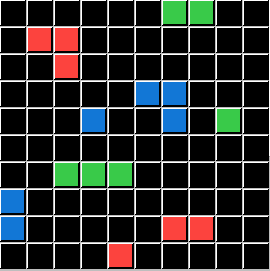
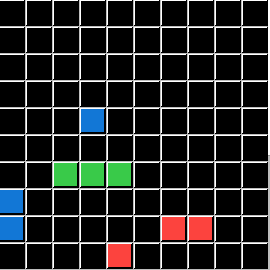
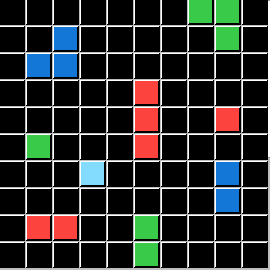
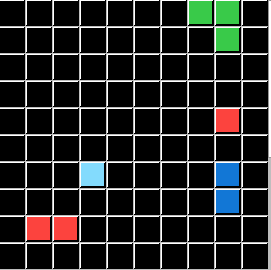 ⇨ ?
⇨ ?
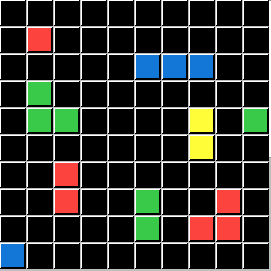
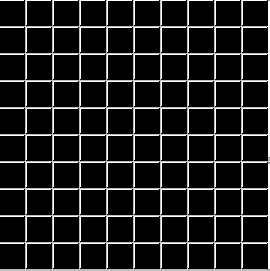
Four Horsemen of Intelligence
Françios Chollet defined "four broad categories" that should be hard coded into any AI system attempting General Intelligence. My intent has been to demonstrate that ARCHIE operates through these fundamental priors:
- Objectness and Elementary Physics — ARCHIE operates on the Principles of OBJECT Cohesion and Persistence, and recognizes shallow and deep Occlusion.
- Agentness and Goal-Directedness — ARCHIE determines which OBJECTS are passive and which drive change between the Input and Output Grids.
- Natural Numbers and Elementary Arithmetic — ARCHIE identifies and records OBJECT Attributes as Cardinal, Ordinal, and Normative values.
- Elementary Geometry and Topology — ARCHIE captures the distance, orientation, and topographic relationships between multiple OBJECTs and the Grid.
Top Down or Bottom Up?
I find the best results when designing a complex system come from understanding the following:
"Complex Systems that work are INVARIABLY assembled from Simple Systems that work."
You cannot build a complex system straight ahead from scratch. You need a general top-down view of the intended Complex System and must move quickly to identify its required "Capabilities." These capabilities might not be simple systems themselves, so the breakdown process is applied to those next. Ultimately, there will be a more extensive, hierarchical set of Simple Systems. These must be competently created. It's an art. The Simple Systems must function independently. They "must work." But they also require an architecture that incorporates them into the larger complex entity.
As the "Simple Systems" are created and assembled from the bottom up, the next layer in the hierarchy will reveal "emergent properties." These properties may reveal the need for more or fewer of the originally anticipated capabilities. Some emergent properties may appear like magic.
Many ambitious endeavors fail because they start even higher than top-down. They begin as dreams, mature only to fantasies, and end up as Illusions. Then comes the attempt to brute force a direct solution, top-down, which never succeeds.
Complex Systems require a solid architecture and a lot of work.
AGI is Cherry Picked BS, Usually
Brought up in my ELIZA example, much of our detection of non-human intelligence comes from the "theory of mind" and our need to seek out our own kind. We also see faces in tree bark. I have selected a lot of Puzzles to illustrate how ARCHIE works. Several of them were custom-made for this article. I've tried to start with simple examples and build complexity from there. ARCHIE and I have worked through many canonical ARC and other sourced Puzzles. And more are on the horizon.
I use the language of a team because that's what it feels like. When I look at a new puzzle, trying to discern what capability is required to solve it, I frequently have ARCHIE "take a shot" to identify the sticking points. Surprisingly, ARCHIE solves some of these novel puzzles! I started with 9x9 and then 10x10 grid puzzles, and when I shifted to inspecting 3x3 puzzles ARCHIE instantly solved many of them because they were similar enough, conceptually, to utilize exiting ACTIONs. Wow! Those are the simple ones. ARCHIE also solves complex puzzles, but not preemptively. When I started on ARC, I had no idea ARCHIE would need to or could utilize powerful Compound Actions. The capabilities reveal themselves along the way.
The benchmark for the ARC Prize is for your program to solve 85% of the hidden private set, which are supposed to be numerically different but conceptually similar to the public sets. When asked at the UCLA presentation what percentage my program had achieved, I glibly remarked "120% of the puzzles attempted." That's because ARCHIE is not programmed to solve any individual puzzle but rather to have capabilities expressed through ACTIONs and Attributes. ARCHIE deals with variations of known concepts effortlessly.
There is not a definitive list of "cognitive priors" that can be baked into a "requirements document" and then coded. I have looked at a lot of sources (e.g., Gestalt Laws, Bongard Problems, Reebus Puzzles, etc.) and can draw inspiration from them. But unlike "the 5 core symbolic logic statements," there just isn't a comprehensive list of cognitive priors. The value of the ARC Prize Challenge is to explore the space of human abstract reasoning and discover that elusive list yourself.
ARCHIE versus Goliath
Why does any of this matter? If ARCHIE can solve novel IQ Test Puzzles, how will that make anyone's life better in the long run?
ARCHIE is a proving ground that "Classic AI" approaches still work in the right hands. Neural Networks were once written off because practitioners couldn't get past a few roadblocks. The solution for them was to invoke a Massive Increase in SCALE. Massive Scale requires massive resources, and "Big Tech" loves this "barrier to entry." After investing billions, they honestly do not want a "fast and free" system disrupting their hold on the market. I think François Chollet saw this issue up close and consequently created the ARC Prize to see if anyone could work around it. He even stated the solution would likely come from "an outsider." This has been echoed more recently by ARC Prize co-founder Mike Knoop.

The approach matters. If AI continues to become more pervasive, powerful, and deeply embedded in daily life; it becomes a requirement for survival. Preventing a corporate, government, or military monopoly becomes an existential issue. If we can't keep up in an "AI Nuclear Arms Race," perhaps we need a swarm of inexpensive drones.
Atoms on an Endless Sea of Elements
One concern over ARCHIE's design is that there could be infinite cognitive priors. If not an infinite number, then a required combination of priors resulting in an uncomputable "Combinatorial Explosion." The combinatorial explosion is what makes the Traveling Salesman Problem a persistent challenge. After a few handfuls of locations, you cannot brute-force-check every solution. I know this limitation well.
With a combinatorial explosion, you start with a few elements and end up with many. With abstraction and generalization, you start with many elements and end up with few. Abstraction is a process of combinatorial implosion.
Performing a light overview of ARC before designing the "next" action, I found 38 puzzles that appeared to require [EXTEND]. Mirror puzzles, Connect puzzles, and Simple Extends that could all use the same Action. Instead of 38 new Actions, only a single Action is required if coupled with a small number of flexible parameters. I am confident that ARCHIE will continue to solve unknown puzzles with existing Actions.
In the 17th Century, Gottfried Leibniz suggested the creation of a characteristica univeralis. This would be an image-based "alphabet" that would allow abstract reasoning to form a general algebra. His vision was that this abstract language of concepts would be processed in an unambiguous way, as numbers are in mathematics. The end result would be an "Abstract Reasoning Calculus."

Many have considered this quest folly, asserting there are too many potential concepts, too many "elements of thought." In Leibniz's time, both he and Isaac Newton were alchemists, searching for a "philosopher's stone" to bind the seemingly infinite elements of Life together. The work of the Alchemists directly lead to the discovery of the Periodical Table of Elements. For atoms that occur in nature, the Table catalogs under a hundred, and only a quarter of those account for all Life. In the physical realm, 25 atomic elements answered the question.
Similarly, for the multitude of variations possible with DNA, just 4 base pairs encode all 20 amino acids. We see this trend repeating in Nature. Though tricky to discover, the building block set is just not that large.
The number of critical elements is never just one, nor is it unlimited.
The answer can be revealed with only a handful of gems.
And ARCHIE will find them...
Epilogue
I set out building ARCHIE in order to discover the "Cognitive Priors" revealed by ARC Puzzles. I didn't start with a preconceived model of intelligence. That is something which developed organically.
In designing an application to solve the puzzles, I first had to programmatically recognize what constitutes the "Background" of an image. Then, I had to formulate the rules under which non-background pixels comprised "Individual Objects." The objects required grouping and analysis independent of their originating grid. In short, I had to discover and implement the rules of a primitive visual system.
Solving any ARC Puzzle requires identifying what changes happened to which objects and why. It also requires abstracting rules that account for all changes in the "Example Grids," which can then be deterministically applied to the "Test Grid."
Changes to Objects are executed through Actions. Actions have Parameters which facilitate a wider range of functionality. Objects have Attributes that identify them as targets for Actions, and sometimes modify Action functionality as well. Through ARCHIE, I discovered that Objects, Actions, Attributes, and Parameters are critical requirements for the Causal Model of Abstract Reasoning.
It turns out that these four elements are identified in Linguistics under different names: Objects == Nouns, Actions == Verbs, Attributes == Adjectives, and Parameters == Adverbs. What starts as a primitive Visual System gives rise to a Proto-Universal Grammar.

In the quote above, Professor McWhorter makes a minimalist case for "Universal Grammar." The field of Linguistics is rife with a "Nature vs Nurture" debate: What is instinct versus what must be learned? With ARCHIE, I am suggesting that what developed was a "Proto" Universal Grammar, originating in a primitive visual system designed for determining cause and effect. Compared to the most basic organic brain, it's very minimal. So it's amazing that this minimal system can still solve ALL the Symbolic Logic scenarios (see Part 6).
Aside from being "Orthogonal" to the popular LLM approach, ARCHIE moves the needle forward toward understanding General Intelligence. If ARCHIE can solve Logic puzzles, is this a hidden capability of all visually equipped creatures? It seems as though it should be. Or are Recursion or Clausal Embedding some kind of capability bridge?
Further exploration with ARCHIE should provide insight into this mystery.
Afterword: ARC-AGI-2 and ARC-AGI-3
ARCHIE was created to discover solutions within the ARC Challenge world of puzzles. The first puzzle corpus (ARC-1) ran from 2019 through 2024. Although a monetary prize was offered, ARCHIE was not eligible for technical reasons: It was not written in Python and did not utilize the required Jupyter or Kaggle notebooks. As much as the ARC marketing talks about encouraging "new ideas," the competition is functionally limited to Neural Network type models.
For ARCHIE, the real prize is discovering Human Cognitive Priors implicit in the 'corpus.' Not every puzzle is a good candidate for this. Some are obtuse and will not be solved by children or even impatient adults. A few present ambiguous solutions. Many have unnecessary complications like non-square and mismatched dimensions. Since there are a lot of good, unique puzzles that seem to have instantly recognizable solutions (to a motivated human puzzle-solver) I focused on those first. ARCHIE was able to solve 58% of that limited ARC-1 set.
In 2025, the ARC prize announced an upgraded 'corpus.' The announced goal of ARC-AGI-2 was:
"even harder for AI (in particular, AI reasoning systems), while maintaining the same relative ease for humans. Pure LLMs score 0% on ARC-AGI-2, and public AI reasoning systems achieve only single-digit percentage scores."
Assuming ARCHIE would be starting from scratch with ARC-2, I did an analysis on the new puzzle names and apparent types. As advertised, there is an extended count of puzzle files for training. From ≈400 in ARC-1 to ≈1000 in ARC-2. However, the ≈600 'new' files for ARC-2 Training are actually from the ARC-1 Evaluation set. This is a combined list of puzzle file names. So how could the LLM progress have dropped to 0% for the same ARC-1 puzzles?
Using ARCHIE to preview and compare ARC-1 and ARC-2 puzzles with the same file names provided an answer for the LLM failures. Although the file NAMES were the same across sets, the contents were modified. Sometimes new examples were substituted, and tests were modified. Sometimes, the solution to an ARC-1 test would be totally different in the ARC-2 version since the examples had changed. Any system memorizing file names while "learning from past examples" would be thrown off by this. I'm pretty sure that was the intent.
Because ARCHIE does not memorize file names and treats every puzzle as if it is novel, ARCHIE solved the same 58% of the matching ARC-2 set, right out of the gate. This was a great confirmation that ARCHIE solves puzzles based on concepts it has been taught, and does not rely on raw patterns in data.
I spent time categorizing new puzzles that represented concepts that were new and interested me. Below is a brief survey of these concepts:
Advanced Paint: Hole Count
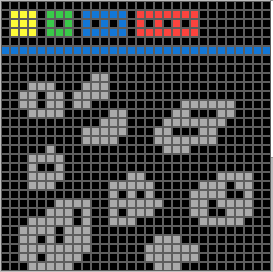 ⇨
⇨
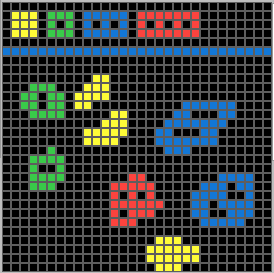
 ⇨
⇨

This is a good ARC puzzle, as a human problem solver can figure out the solution fairly intuitively. This requires the [PAINT] action from Part Three. Another concept carried over from ARC-1 is the concept of a KEY and Key_Items. Above the Blue line are Key_Items, and somehow they provide the map for PAINTING the Grey Objects below them. ARCHIE had not been exposed to the critical concept of HOLES when it tried to solve this puzzle. Interestingly, it figured out which objects are Keys and that they were the colors needed to PAINT the Grey objects, but knew nothing about holes. When I added "hole_count" to each object's attribute upon initialization, ARCHIE easily assigned the correct colors to the correct object based on this new attribute. New capabilities accumulate through the addition of simple attributes.
Flow: Liquifying Solid Objects
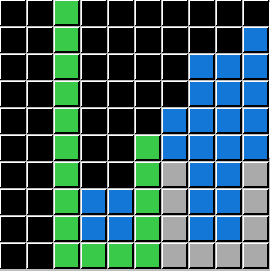 ⇨
⇨
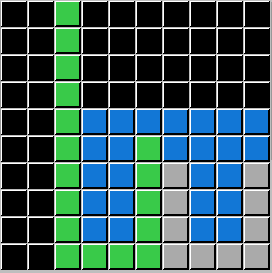
 ⇨
⇨

'Flow' is an entirely new concept introduced in ARC-2. It represents the processes of liquefying a solid object and allowing its contents to flow downward as though by gravity. The Blue color in the stock puzzle above is a hint to human problem solvers that the object should be treated like water. ARCHIE's solution is more generalized and could treat Red objects like Lava, or even change colors like Ice (Teal) melting into Water (Blue).
Wall Follow: Basic Maze Solving Technique
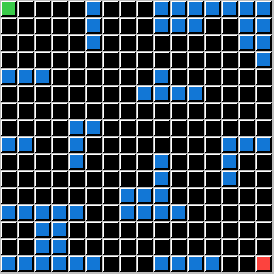 ⇨
⇨
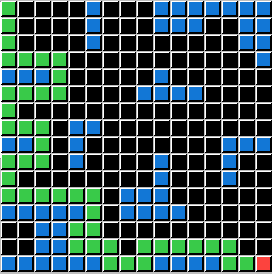
 ⇨
⇨

In Part Four I demonstrated ARC-1 puzzles that required ARCHIE to implement [STROKE] for the solution. With ARC-2, a new "Inner Stroke" transformation was introduced. It immediately reminded me of a basic maze-solving technique for robots called 'Wall-Follow.' A robot can always solve a maze in a determinate number of steps by selecting either the left wall or the right wall and following it exhaustively until reaching the exit. I gave ARCHIE the [Wall_Follow] capability, which also solves the more limited 'Inner Stroke' puzzle. I also added optional start and end pixels (green=start, red=end) as above. If there is both a start and an end pixel, ARCHIE will calculate and then display the shortest path. This demonstrates rudimentary maze-solving!
Cipher: Substitution + Transposition
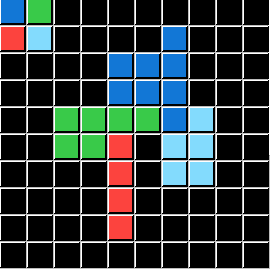 ⇨
⇨
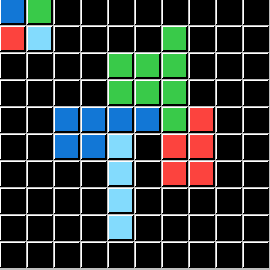
 ⇨
⇨

The (stock) ARC-2 puzzle above enlists two concepts seen in many other puzzles from both ARC-1 and ARC-2. The 4 pixel square in the upper left is a MAP. Colors in the Output grid have been substituted according to this MAP: Blue->Green, Red->Teal, Green->Blue, and Teal->Red. In the typical ARC-1 corpus it would be enough to associate this color mapping as the solution. However, in this ARC-2 puzzle the other Example Grids and the Test Grid utilize entirely different colors! Knowing which colors to map requires a deeper level solution.
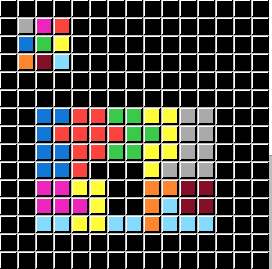 ⇨
⇨
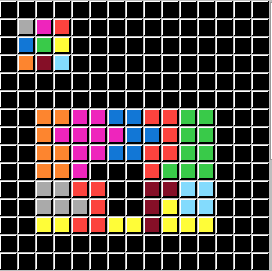
Above is a custom version with a larger map with an overall position shift. The maximum colors are represented. Both the upper and lower example sets represent a CIPHER — an algorithm for encrypting a message. If there ever was an ARC puzzle requiring undeniable abstraction, this would be it. The standard MAP puzzles involve SUBSTITUTION of one color (or object) for another. The CIPHER puzzle adds TRANSPOSITION on top of Substitution, which is required for decoding the Solution. In the top 2x2 Map example, colors next to each other horizontally Map to one another:
[Top-Left<->Top-Right]
[Bottom-Left<->Bottom-Right].
The bottom 3x3 Map, however, follows a completely different pattern for this puzzle (i.e., a spiral). There are (9x8x7x6x5x4x3x2x1)= 362,880 possible mappings with the 3x3 Map.
These shifts work regardless of the colors in each position. The resulting color/position is only then used to substitute colors in the solution grid. An analogy is that the MAP is a 'Public Key', the non-MAP pixels are the 'Cipher-Text', and the 'Private Key' is the pattern of transpositions within the MAP. ARCHIE's [CIPHER] algorithm can quickly solve for all of these.
Jumping the Shark
Concepts like 'Liquefaction', 'Maze Solving', and 'Cipher Decryption' have advanced beyond simple puzzles that children can solve. Are they still cognitive priors, or have they reached a higher level of complexity? I am amazed that these advanced concepts can be represented in the format of the ARC puzzles. Their inclusion is invaluable. Unfortunately, I find many other additions to the ARC-2 corpus unfortunately tedious for humans to work on. A 30x30 grid with missing sections is nothing more than a 900-piece puzzle where every tiny shape is the same. The ARC founders, Chollet and Knoop, have moved on to create their own AI company, Ndea. The ARC Prize Foundation has already announced ARC-AGI-3, which is based on interactive video games.
The future of ARCHIE is to expand its capabilities into solving more difficult problems, like the Towers of Hanoi. This classic puzzle cannot be represented as a commonality between multiple two-state examples. Or is this a limitation of my own problem representation skills?
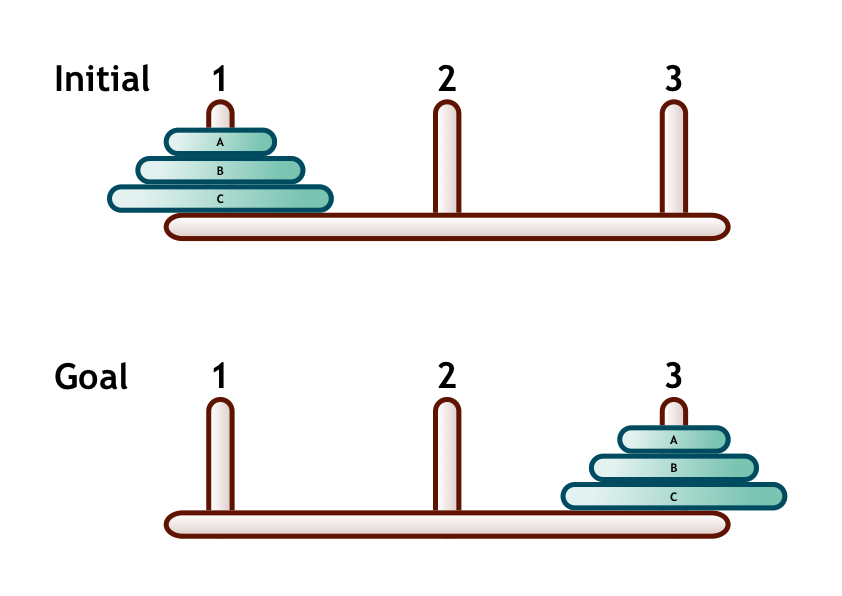
While this diagram represents both the input and output states, the puzzle involves two transformation rules: Only one disk can be moved at a time. A larger disk cannot be placed over a smaller disk.
The other articles in Boundaries of Objectivity will explore this further. You can leave thoughtful comments or questions at the link below.